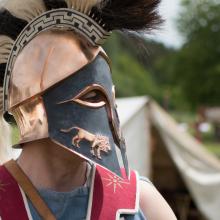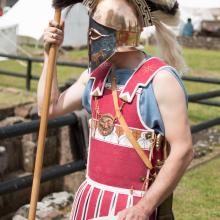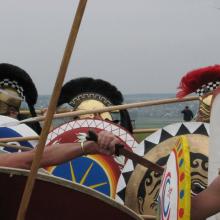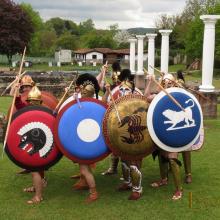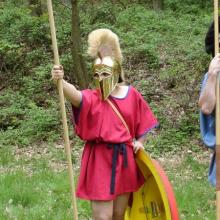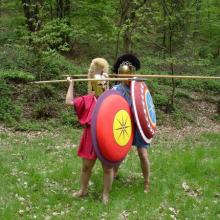The range of our historical impressions reaches chronologically from the Greek classical era in the early fifth century B.C.E. to the second century B.C.E., and geographically from the peoples of Italy, to the Balkans and of course Greece, over the Hellespont into Asia Minor, and further into Persia. The historical focus of the group is ancient Greece, but many of our members have developed secondary impressions from one or more of the areas mentioned above. With enough time to prepare, we are also able to develop a presentation that is specifically tailored to the topic of your event or lesson. If you are interested in working with us, please see our page for interested museums or educational institutions for more details.
If you plan to develop a historical impression based in ancient Greece yourself, we invite you to visit us in our online message board. We are always available to give advice and to answer any questions you might have. You might also be interested in our literature recommendations or list of tools for online-research.
This is a selection of our historical impressions.
The Classical era is the time roughly from the Ionian revolts in the year 500 B.C.E. to the campaigns of Alexander the Great in the late fourth century B.C.E. It is the peak of the Greek Polis, the independent city-state based on the Attic example. However, even during this time there are still tyrants and kings, for example in Sparta. Our modern impression of the Classical era is largely shaped by the dominance of Athens, which over a long time represented the mightiest military power in Ancient Greece, fueled by the military victories in the Persian wars. Besides Athens, there were other important centers, such as Thebes, Corinth, Delphi, Sparta, or colonies like Syracuse and Ephesos.
Hoplites formed the backbone of the armies fielded by the Classical Greek Poleis. In their role as heavy infantry, they were in the thick of the fighting, and their equipment reflects that fact. The core of the armament was a large concave shield, about one meter in diameter, called the Aspis. The front of the shield was usually painted, originally with individual motives, but later some Poleis adopted a uniform shield pattern for the whole army. The Hoplite is protected by a helmet, a torso armour, and greaves. The most popular helmet is certainly the Corinthian type, which was in use up to the middle of the fifth century B.C.E. It was then replaced by lighter helmets, such as the Chalcidian, Attic, Phrygian, or Pylos type. The main weapon of the Hoplite was the Dory, a lance that measured about 2.50m.
A field smithy is an essential accessory in any army camp. The soldiers can perform small repairs of their equipment, and produce metal pieces, such as spearheads and arrowheads, or caltrops. In our impression, we don't only craft military items, but mostly produce small utensils for ourselves, such as tools, or cooking utensils.
The forge is build from clay and is fired using reconstructed bag bellows.
The Ekdromos was a variation of the Classical Hoplite, who was armed in a lighter fashion. The name translates to out-runner, which allows us to infer their tactical use. Ekdromoi could fight in the closed Phalanx formation, just as regular Hoplites. However they could also quickly break ranks to run down fleeing enemies, or engage skirmishing troops in close combat, or at least drive them off the battlefield. Ekdromoi were typically armed in the same fashion as Hoplites, with the large concave shield, the Aspis, and the Dory, a lance about 2.50m long. They would have only worn a helmet for additional protection, because a torso armour and especially greaves would greatly hinder them while running.
Psiloi was a term used to describe any light troops in a Classical Greek army. Since the individual soldier had to purchase his own equipment, they usually consisted of men, who were not able to afford the panoply required to serve as an Ekdromos or Hoplite. Typical Psiloi were armed with various missiles, slings, or bows. They are also distinguished in ancient literature based on their weaponry. There are the Akontistai armed with javelins, the slingers Sphendonetai, the archers Toxotai, and the stone-hurlers Lithoboloi, who were certainly part of the poorest class within a city. According to their lacking equipment, they were used as skirmishers, to incite chaos and confusion within the enemy ranks, and protect the own formations from enemy skirmishers, or to occupy locations of tactical importance.
The era immediately following the Greek Classical era is called Hellenism. It begins with the campaigns of Alexander the Great in the year 334 B.C.E, and ends with the establishment of a Roman protectorate in Ptolemaic Egypt in 30 B.C.E. The Hellenism was shaped by the cultural exchange with the areas conquered by Alexander the Great, the Romans, the Carthaginians, and the Galatians and Celts from the Danube river. Bigger kingdoms and states dominated the political landscape instead of the Classical Polis. Although many Poleis were founded in the Hellenistic era, they were usually not independent, but under a protectorate of a bigger party. At the end of Hellenism, the Republic of Rome dominated the whole Mediterranean, and the formerly massive empire of Alexander the Great was no longer under Greek influence.
Philip II was born in the year 382 B.C.E. ans spent his youth as a hostage in Thebes, where he studied the new military tactics of Epaminondas. He ascended the throne of Macedonia after the death of his brother Perdikkas in 359. He defeated the Illyrians and Paionians and accepted the title of king. In the year 357 he conquered Amphipolis, and one year later the cities of Pydna and Poteidaia. In this time he was allied with Athens and Chalkidike, to prevent war on multiple borders of his empire. In 356 he defeated an Illyrian-Thracian coalition, which was supported by Athens, which allowed him to gain control over the mount Pangaion with its rich silver mines.
Philip now turned his attention to Greece. He conquered Thessaly and defeated the Phocian king Onomarchos in 352, and established a Macedonian garrison in Pagasai. At the same time he sought to expand his influence over Illyria and Thrace. In the year 348 B.C.E. Philip completed his conquest of the Chalkidike by taking the city of Olynthos. Philip then sought to strengthen his position in central Greece. He subdued Phokis and negotiated the peace of Philokrates with Athens. He was named Archon of Thessaly for life, and was again looking to expand his power in Thrace. In the year 338 B.C.E. he won a decisive victory over a coalition of Athens and Thebes in the battle of Chaironeia. Philip established the league of Corinth, and was named its Hegemon. With his position in Greece firmly established, he went on to prepare his campaign against the Persians.
The Hypaspists were an elite unit with aristocratic roots in the army of Philip II of Macedonia. The name literally translated to shield-bearer, and their mentions in ancient Texts, and use as a guard of honour, might suggest that they developed from the personal bodyguards of the Macedonian kings. Under Alexander The great, the Hypaspists grew to 3,000 men and formed a unit, which was usually deployed on the right flank of the center phalanx. Their role was to protect the vulnerable flanks of the phalanx and keep in contact with the cavalry, which was again deployed to the right of the Hypaspists.
The backbone of the Macedonian army was the Phalanx, an improved version of the traditional Greek phalanx, that was equipped with longer lances and fought in a tighter formation. The men serving in the phalanx regiments were called Phalangites or Pezhetairoi (Greek: companions on foot). Their equipment was tailored to their way of fighting. The wielded the famous Sarissa, a lance with more than twice the length of the Dory carried by Classical Hoplites. Consequently they had to carry smaller shield, which enabled them to use two hands to control the Sarissa. The longer reach of the Sarissa compensated for the lowered protection of the small shield. For additional protection they carried a helmet, a torso armour, and greaves.
Wie in jeder hellenistischen Armee seit Alexander dem Großen, nahm die Kavallerie in der Armee von Pyrrhos eine besondere Rolle ein. Ihr gebührte üblicherweise die Aufgabe die Schlacht zu entscheiden, weshalb hellenistische Könige auch oft selbst an der Spitze ihrer Reiterei in die Schlacht ritten.
Diese Darstellung basiert auf einem Fund aus dem Dorf Prodromi in Thesprotia, das auf dem Gebiet des damaligen Epiros liegt. Es handelt sich um ein Schachtgrab, das Ende der 1970er Jahre von einem Bauern entdeckt wurde. In dem Grab befanden sich unter Anderem ein eiserner Torsopanzer, zwei eiserne Helme, einer davon versilbert, ein eisernes Schwert, so wie eine dazugehörige Schwertscheide ebenfalls aus Eisen. Die Länge des Schwertes und die Beschaffenheit des Panzers lassen darauf schließen, dass es sich dabei um die Ausrüstung eines Reiters handelt.
Neighbouring Cultures
Ancient Greece has a long tradition of cultural exchange with neighboring peoples. Greek influences can be found in a great number of ancient cultures, ranging from western and central europe to the steppes of Asia, and from India into the African continent. Vice-versa the Greek culture was influenced by its neighbors. Especially the era of Hellenism, which started with the campaigns of Alexander the Great, facilitated a rapid and long-lasting cultural exchange.
In order to present our audience with a complete picture of ancient Greece, we strive to also understand various cultures, which practised cultural exchange with the Greeks by trading, by religion, or by waging war against each other.
When we mention the ancient Persians, we mostly think of the Achaemenid empire, which existed from 550 B.C.E. to its conquest by Alexander the Great in the year 330 B.C.E. The Persians were not a homogeneous people, but a multitude of smaller tribes and cultures. However, the ancient Greeks mostly did not distinguish between the individual groups, and that is why we are using the collective term Persians as well. The Achaemenid empire was founded by Cyrus II, later called the Great, who initially ruled over a vassal kingdom in the Median empire. Cyrus managed to break free from Median control, and afterwards went on to conquer the whole Median empire for himself. Shortly afterwards, he managed to defeat Croesus and gained control over Asia Minor, including the Greek cities there, and afterwards he acquired Babylonia. His successors managed to add Egypt, Thrace, and parts of India to the kingdom.
The Thracians were an indogermanic people in Southeast Europe and Southwest Asia. They had close contacts with the greek culture. They were organized in tribes, which were lead by chieftains or kings. The bulk of their soldiers was formed by Peltasts (javeliners, slingers and archers). They were equipped with shields in different forms, the so called Peltes, javelins and swords of different types like Kopis, Rhomphaia and Xiphos.



